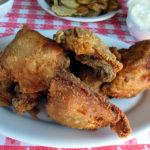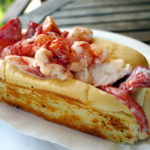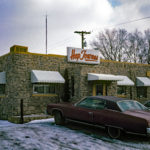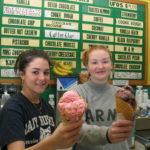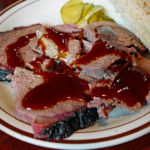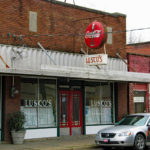I Like to Watch People Eat
In 1961, when I was 14, I played hooky, rode the morning commuter train from the Chicago suburbs to the Oriental movie theater downtown, and saw Nicholas Ray's The Savage Innocents three times in a row. I had a fresh bucket of buttered popcorn at each showing. I loved the scene in which Anthony Quinn, playing an uncorrupted Eskimo, offers Peter O'Toole, a reluctant lawman who must arrest him, the ultimate in native hospitality: his wife for the evening and a bowl of their igloo's oldest meat, crawling with maggots. The largesse of the gift was a bit beyond adolescent comprehension, but that bowl of rotten meat sure got my attention. When I subsequently teased my younger sister with live worms, I justified the behavior as "anthropological."
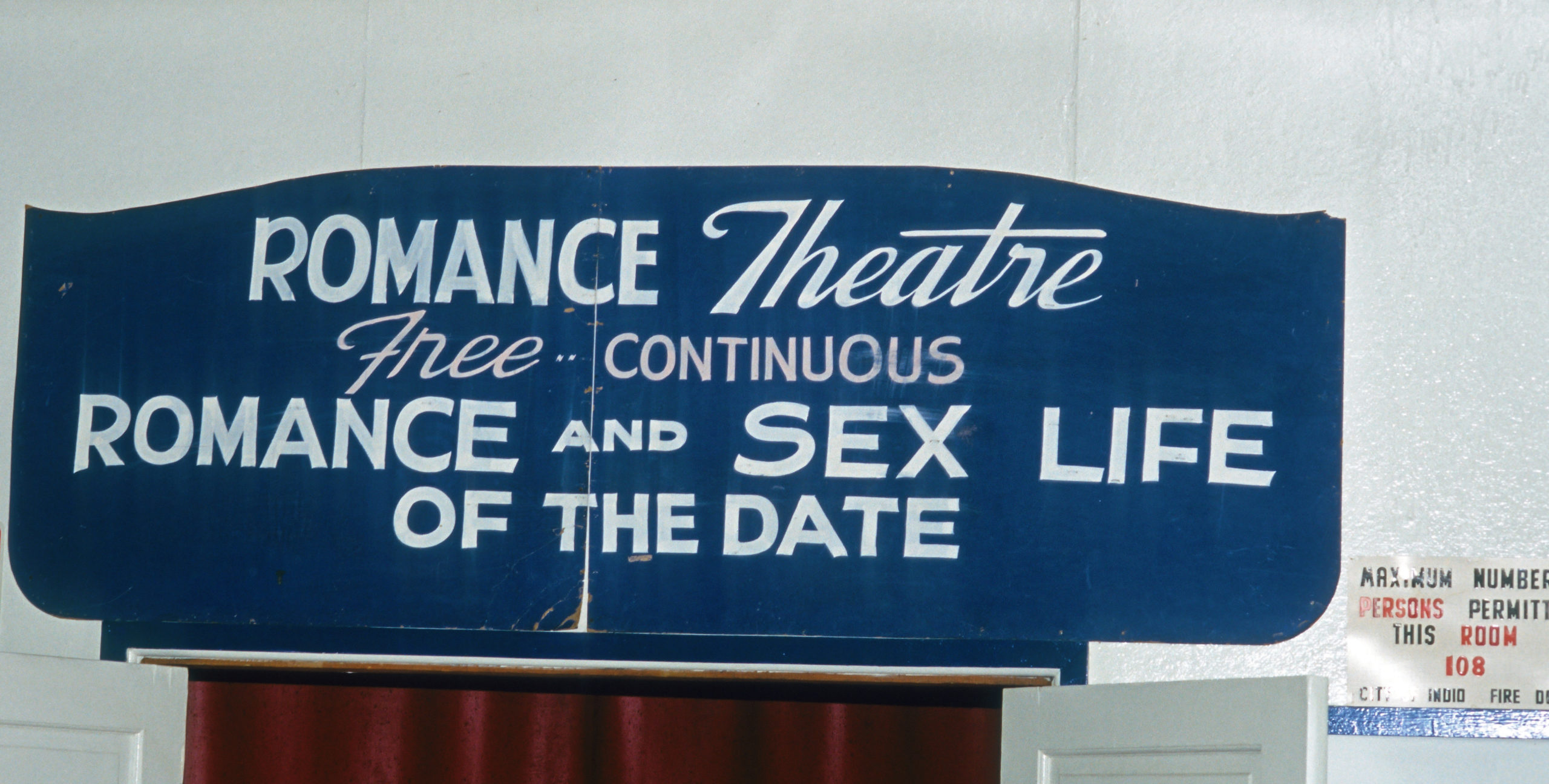
By Jane and Michael Stern
Originally Published 2000 Gourmet Magazine
In 1961, when I was 14, I played hooky, rode the morning commuter train from the Chicago suburbs to the Oriental movie theater downtown, and saw Nicholas Ray’s The Savage Innocents three times in a row. I had a fresh bucket of buttered popcorn at each showing. I loved the scene in which Anthony Quinn, playing an uncorrupted Eskimo, offers Peter O’Toole, a reluctant lawman who must arrest him, the ultimate in native hospitality: his wife for the evening and a bowl of their igloo’s oldest meat, crawling with maggots. The largesse of the gift was a bit beyond adolescent comprehension, but that bowl of rotten meat sure got my attention. When I subsequently teased my younger sister with live worms, I justified the behavior as “anthropological.”
I learned most of what I knew about the world beyond my hometown from movies. I was especially intrigued by meal scenes that seemed so different from my family’s square meals and the efficient cafeteria at New Trier Township High School. When I went on a gangster-movie bender in my early teens, I gaped in awe at a scene in a night-owl diner early in Little Caesar during which Edward G. Robinson plots his rise from small-time crook to gangland kingpin. It was a setting as bleak as Edward Hopper’s NightHawks, just a deserted counter in the naked city, a hash slinger with his sleeves rolled up filling thick cups with heavyweight Java. You could almost smell the residue of frying lard in the air. To this nice Jewish boy, brought up in a nice middle-class home in the pleasant village of Winnetka, the ghastly greasy spoon was more alluring than Paris or Vienna.
There happened to be a Toddle House diner on Green Bay Road, which was a 30-minute bicycle ride from my house. It was a dive reminiscent of the one in Little Caesar, a place where truckers going from Chicago to Milwaukee stopped for a wedge of pie as their idling vehicles filled the air outside with an acrid engine stench. The scene reminded me of Marlon Brando and his gang of bikers hauling into town for beers in The Wild One. For New Trier boys who craved a taste of the wild side, a seat at the Toddle House counter was a perch in outlaw heaven, a film noir in which we were extras. In fact, when my friends and I started making 8-mm movies, we tried to use the Toddle House as a location for a shootout. The no nonsense proprietor gave us the boot; and besides, at age 15, in chinos and Madras shirts, none of us made convincing gunsels.
Getting a driver’s license meant I could take dates to drive-in restaurants. My model was Tom Neal, the on-the-lamb chump in Edgar G. Ulmer’s ultra-noir Detour, who finds himself sitting in a stolen car with black-widowy Ann Savage, wearily ordering a ham sandwich and a cup of coffee. I really wanted to order a ham sandwich and a cup of coffee, too, believing that my rendition of that film’s angst would somehow impress dates; but alas, by the mid-1960s most of the drive-ins I frequented on the North Shore of Chicago were already imitating McDonald’s burger-driven menu. Their clean and happy atmosphere totally gave the lie to my pose as a 16-year-old victim of existential malaise.
Of course, I often went to drive-in movies because they were good places to neck; but I also went to see the movies! Even more bizarre, I went to eat. I loved drive-in food, hideous as most of it was, and to this day, when I spot an extant drive-in somewhere along the road, I wonder what they serve at the refreshment stand. I honestly don’t remember having much time to kiss and coo, but I clearly recall staggering back to the car toting trays piled high with heat-lamp pizzas, sloppy-joe sandwiches, huge dill pickles, and off-brand candy bars. I knew it was awful, but somehow the pleasure of eating in the car while watching a movie transcended the food, the way state-fair corn dogs taste good because of the setting.
Although booze was not a big part of my family’s social life, I started drinking in my teens, and I learned how by watching movie characters. In those adolescent years, when gangsters were my culture heroes, I devoured the notorious scene in Public Enemy when James Cagney squishes a grapefruit in Mae Clark’s face at the breakfast table. He does so because she questions his choice of a morning beverage—beer. Until that moment, I never thought of drinking beer with my Shredded Wheat. When it came time to choose a college and a career, I selected the School of Advanced International Studies at Johns Hopkins University so I could become a spy. My role model, of course, was suave-drinking James Bond (Dr. No, the first Bond film, came out in 1962). It’s a little embarrassing to admit that for years thereafter I requested that my Martinis be “shaken, not stirred.” (On the other hand, I am happy to say that I got sober before the release of Leaving Las Vegas.)
The food at the Johns Hopkins commissary was excellent—prepared by veteran southern cooks who were masters of the waffle iron and the chicken-frying skillet—but I soon realized that espionage was not my destiny. So I switched to the University of Michigan, where I could major in American Studies, a field that allowed me to justify watching movies almost around the clock. I was particularly interested in films that explored everyday life, including what people ate and how they behaved at supper. While many of my fellow film buffs focused their attention on the “art of cinema,” I was drawn to pictures that showed dad carving a roast at the dinner table, or teens sucking down malts at a drive-in, or cowboys yanking sourdough biscuits from a Dutch oven at a campfire. Other details of everyday culture—fashion, slang, and leisure time—were on my radar screen, too, but film food scenes were an endlessly seductive spectacle. Movie meals became my Rosetta stone, providing a key not only to the disposition of America, but to where I fit in the cultural scene.
I gravitated to the era’s domestic dramas in which supposedly normal life crumbles into despair—often at family dinners. I was like so many adolescents who grew up in the 1950s and I found in James Dean my avatar of frustration. Dean’s sense of alienation in Nicholas Ray’s Rebel Without a Cause is epitomized by the nearly farcical scene in which he writhes in agony as he watches his spineless father (Jim Backus) tidy up the kitchen while outfitted in a ladies’ apron. Likewise, James Mason’s demented rage when his frightened son spills milk in Ray’s Bigger Than Life was a fierce reminder that the dinner table, which conventional wisdom tells us should be a place of comfort, was sometimes fraught with fear and menace.
A turning point in my life came in August 1968, during one spectacular week in which I was beaten by Chicago police outside the Democratic convention and introduced to the films of director Dougas Sirk. In Sirk’s precisely crafted morality plays about polite, middle-class people who find their world collapsing I found the perspective of a kindred outsider. Sirk savored the nurturing myths of American culture while exposing the desperation of people who felt betrayed by it. As a middle-class collegian roughed up by Mayor Daley’s troops in Grant Park, I could relate!
The Sirk picture that became my touchstone for seeing material culture as an expression of spiritual condition was All That Heaven Allows. It presents Jane Wyman as a suburban widow with a clear choice of men: predictable old Conrad Nagel, whom her children think is appropriate, and studly young Rock Hudson, the gardener whom her children consider beneath her. Nagel, who moves through scenes with all the verve of a mummified Richard Nixon, drinks meticulously made Martinis (one per night) and dines in a tuxedo with the nabobs of the country club; Rock, in the pink of well-muscled manhood, takes Jane to a potluck party on a makeshift table of wood planks and sawhorses where the eccentric, artistic guests wear plaid shirts. They drink “The Anderson Special”—a little of this, a little of that, with none of the stultifying rituals of 1950s Martini culture—and they eat lobsters brought fresh from the boat by a jolly guest known as “The Lobster King.” There is far more to this movie than a choice of food styles, but the clear dialectic of country club versus potluck supper had a profound influence on my own taste and appetite, steering me to seek out informal meals and unpredictable dining companions, and to try to define a genre of eating that my future wife, Jane, and I eventually called “roadfood.”
When Jane and I started traveling in the early 1970s, the simmering discontent that had insinuated itself into Hollywood melodramas of the 1950s had surfaced as on-screen rebellion. I set off to eat my way around America with long hair and a surly attitude—ready, willing, and eager to reenact Jack Nicholson’s contretemps with the diner waitress in Five Easy Pieces when he tries to get an order of toast. But I never had the opportunity to take my stand against the establishment and sweep all the glassware off the table in a fit of justifiable rage about meaningless rules. Waitresses we met in the early days of our Roadfood books were nice; we could always get an order of toast on the side, even if the menu said “No Substitutions.”
I also set off with a good measure of paranoia, thanks mostly to Easy Rider, which featured a café scene in which nasty rednecks hassle the free-spirited travelers (Peter Fonda, Dennis Hopper, Jack Nicholson) whom the staff refuse to serve. That confrontation loomed as ominously in my mind as the shower scene in Psycho, and for years every time I walked into a small-town café, I was poised to run or to fight. It took a long time to realize that the locals’ stares were not malicious, as in the Hollywood fantasy of rustic life; the regulars were just curious about strangers. Eventually, we found our home in all those diners and cafés that, like the Toddle House, once seemed so exotic.
All my life I relished movies because they offered a window into other worlds or a new perspective on my own. As I have eaten around the country, countless plates of food shared with fried-bologna trailerites and tea-sandwich socialites have provided the same sort of insight. For me, the way we eat is a reflection of who we Americans are—on a blue plate instead of a silver screen. Thirty years ago I was watching six movies a day; now, I eat six meals a day. Either way, I’m always hungry for more.
Discuss
What do you think of I Like to Watch People Eat?
Related Articles
Stroud’s
By Jane and Michael Stern Originally Published 1995 Gourmet Magazine Chicken...
The Lobster Roll Honor Roll
Maine is the only state in America that features a picture of cooked food on its license...
Meat-And-Three
A few years back, country singer Ray Stevens invited a New York friend to join him at one of...
Top 12 favorite Ice Cream Scoops
WITH THE EXCEPTION of the hot dog bun, there has never been an edible invention as...
Top 5 BBQ Restaurants | Western Kentucky
Get yourself to Western Kentucky for great BBQ I see the food shows on TV where...
Best restaurants in Greenwood, MS | Hot Licks Delta Style
Ever since we first ate margarine-sauced pompano at Lusco’s, in Greenwood,...

